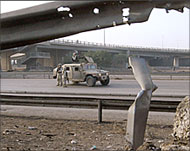Damage Control
Eight heavily armed US soldiers dismounted from two armoured Humvees and quickly began halting all traffic at a four-way intersection.

As our car had already past their perimeter, we were allowed to proceed.
However, as we slowly rolled past the rest of the American convoy, I quickly realized the reason behind the increased security.
Strapped to the back of a large flatbed truck was the burnt and twisted wreckage of an Apache attack helicopter.
On a smaller vehicle a few metres beyond was a pile of blackened metal which appeared to consist of the Apache’s engines and other various bits of debris.
Although I did not expect a positive response, I told the driver to stop so that I could inquire as to whether or not I could take some photos.
Get the hell out!
When the Master Sergeant in charge of the security detail spotted my camera, he immediately aimed his assault rifle at my chest and shouted, “Don’t even think about it! Get the hell out of here now!”
As I turned to comply, an American NCO added, “And if you’re smart, you’ll forget what you think you saw here!”
A US soldier at the front gate of the Kirkuk airfield had been quick to solve the mystery for me: The Americans were transporting the destroyed Apache to their airbase in Tikrit, and they had come south on the single highway from Kirkuk.”
|
“Everyone is under extreme pressure to suppress any negative information”
Eddie Calis |
That was the Apache that caught fire and blew up on the flight line,” said Specialist Mark Johnson, a military policeman from Iowa.
“The mechanics responsible are in real deep shit about it, and the brass are trying to keep the whole thing quiet.”
No publicity
Understandably, the US military would not wish to publicise such embarrassments as the accidental destruction of a $22 million high-tech helicopter.
However, given that the wreckage was transported in broad daylight along a 120km stretch of highway, the local civilian gossip mill would undoubtedly be abuzz with false stories of an Iraqi resistance success against the Americans.
“The flow of accurate information is definitely a real problem for us,” explained Eddie Calis, the director of US security at the Kirkuk airfield.
“We don’t always get the complete picture ourselves, and everyone is under extreme pressure to suppress any negative information.”
One of the contributing factors to this communication vacuum is the US military’s rigid adherence to its various reporting chains of command.
Communication problems
“If there is a security incident at the [army] base in Kirkuk, they will report it to the Fourth Infantry Division in Tikrit,” said Calis. “Although we are in the same city and possibly at risk, we will not be informed because we are air force.”
The same restrictions apply to the reporting of US casualties.
“I can only tell you about the numbers which are processed through our aid station,” said Major Courtinez, a medical officer with the 82nd Airborne Division.
 |
|
Resistance and destruction are |
“As for the overall casualty numbers, we can only piece together our estimates based on media reports.”
Unfortunately, since mid-summer, the US military policy has been to only issue press statements concerning incidents where American personnel are killed.
Wounded to dead ratios
In the majority of the Iraq ambushes, the enhanced protection of body armour and quick access to full medical treatment centres has meant US soldiers are wounded far more often than killed.
“The ratio of severely wounded to dead would be running at about 10 to 1,” said Courtinez.
Based on that assessment, the US military has suffered more than 3000 combat-related casualties since the start of hostilities in March.
In addition to the front-line fighting, stress and plummeting morale are also taking their own deadly toll on US soldiers.
Anti-suicide counselling
In recent weeks, the Americans have begun implementing a rest and relaxation program which allows soldiers a 15-day trip back to the States.
However, it is now mandatory for all soldiers to participate in a reunion/suicide-prevention program before their R&R begins.
Posted along with routine orders at the base in Tikrit was an advisory that “emergency individual [suicide] briefings can be arranged through the Chaplain’s office.”
Having just completed his pre-R&R counselling, Sgt. Nystrom of the 173rd Airborne Brigade explained the concern: “Nobody is worried about the soldiers going home.
“It’s just that ticking mental time bomb as they countdown their 15 days of leave, knowing that they have to come back to this shithole in the end.”